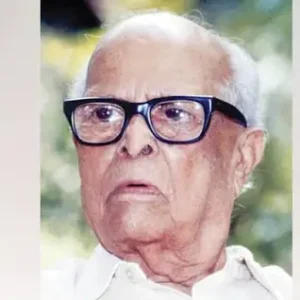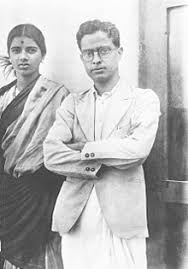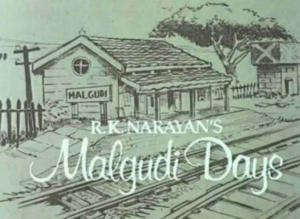Table of Contents
R.K. Narayan, also known as Rasipuram Krishnaswami Iyer Narayanaswami, was a famous Indian writer who wrote stories in English. He wrote fiction, non-fiction, and mythology tales that people all over the world loved for the connections he made with the life of people. Some of his best books are “Swami and Friends,” “The Bachelor of Arts,” and “The English Teacher.” In “Swami and Friends,” he made up a town called “Malgudi.” People often compared him to William Faulkner because he portrayed characters and society so well.
R.K. Narayan had a great career that lasted almost sixty years. He got many awards for his writing, including the AC Benson Medal from the Royal Society of Literature, the Padma Bhushan, and the Padma Vibhushan, which are the top civilian awards in India. He was even nominated to be in the Rajya Sabha, which is India’s upper house of Parliament.
R.K. Narayan- Early life
- R.K. Narayan was born into a Tamil Brahmin family in Madras, during India’s colonial period. He was the second of five sons, with two daughters also in the family. His father, a school headmaster, taught him during his early years. One of his brothers, Ramachandran, became an editor at Gemini Studios, while another, Laxman, became a cartoonist. Due to his father’s job transfers, he spent much of his childhood with his maternal grandmother, Parvati.

- Under his grandmother’s guidance, he learned arithmetic, mythology, classical Indian music, and Sanskrit. Despite his family’s apolitical stance, Narayan developed political views at age 12 and participated in an independence march, earning him a reprimand from his uncle.
- When his father was transferred to Maharajah’s College High School, the family moved to Mysore, where Narayan developed a love for reading and writing. He enrolled at Maharaja College of Mysore in 1926, earning his Bachelor’s degree after four years. Despite initially teaching at a school, he realized his true passion lay in writing and quit to focus on his novels.
- His first published work was a book review, followed by his debut novel “Swami and Friends,” which faced rejection from multiple publishers. In 1933, Narayan married Rajam, whom he met while vacationing. He began working on a paper called The Justice, championing the rights of Non-Brahmins, which brought him recognition and contacts. Meanwhile, Graham Greene’s interest led to the publication of “Swami and Friends” in 1935, followed by “The Bachelor of Arts” in 1937, and “The Dark Room” in 1938, which explored domestic conflicts.

- Tragedy struck in 1939 when Narayan lost his wife to typhoid, leaving him to raise their daughter Hema alone. This loss inspired his novel “The English Teacher,” reflecting his grief. He found success with “Malgudi Days” in 1942 and “The English Teacher” in 1945. Unable to publish in England due to World War II, he established Indian Thought Publications, which thrived.
- Throughout his life, Narayan remained unmarried, dedicating himself to his writing. His works continue to be cherished, managed by his granddaughter through Indian Thought Publications.

The years of Intense Dedication
- During the period following “The English Teacher,” Narayan’s writing took a more imaginative turn, departing from the autobiographical style of his earlier works. His novel “The Financial Expert,” penned in 1951, is hailed as his masterpiece and one of the most original pieces of fiction from that year. Following this success, “Waiting for the Mahatma” explored Mahatma Gandhi’s visit to the fictional town of Malgudi.
- In 1953, Narayan achieved a significant milestone in his career when his work was published in the United States by the Michigan State University Press. Despite his daughter’s wedding, Narayan maintained a rigorous writing schedule, often producing at least 1500 words per day even while travelling. He kept a daily journal, later incorporated into his book “My Dateless Diary.”
- “The Guide,” regarded as his quintessential work, earned Narayan the prestigious Sahitya Akademi Award in 1960. He continued his literary success with “The Man-Eater of Malgudi” in 1961, followed by extensive travels to Australia and the USA. During a three-week lecture tour in Adelaide, Sydney, and Melbourne, funded by the Australian Writers’ Group, Narayan shared insights into Indian Literature.
- His flourishing career brought both literary acclaim and financial stability. Narayan enjoyed a lavish lifestyle, residing in a spacious house in Mysore, contributing to magazines and newspapers like The Hindu and The Atlantic, and driving a new Mercedes-Benz.
- In 1964, Narayan ventured into mythological literature with “Gods, Demons and Others,” a collection of short stories from Hindu epics. “The Vendor of Sweets,” published in 1967, marked another milestone in his literary journey. That same year, Narayan received his first honorary doctorate from the University of Leeds during a visit to England.
- Expanding his mythological repertoire, Narayan published his first mythological work in 1964, ‘Gods, Demons and Others’, it was a short story collection from Hindu epics. He published his next work in 1967, ‘The Vendor of Sweets.’ He also travelled to England this year, to recieve his first honorary doctorate from the University of Leeds. He added more to his mythological work with, ‘The Ramayana’ (1972) and ‘The Mahabharata’ (1978), adding depth to his exploration of Hindu epics. Throughout his endorsed years, Narayan’s literary contributions continued to captivate audiences worldwide relating to them as his techniques contained a natural humor and ordinary connections describing the demands of society.
Overview of RK Narayan
The information about the RK Narayan is mentioned below. Check it out
| RK Narayan: Overview | |
|---|---|
| Full Name | Rasipuram Krishnaswami Iyer Narayanaswami |
| Date of Birth | October 10, 1906 |
| Place of Birth | Madras, British India (now Chennai, India) |
| Education | B.A. from Maharaja’s College, Mysore (now University of Mysore) |
| Career | Novelist, Short Story Writer, Essayist |
| Awards | Sahitya Akademi Award (1958), Padma Bhushan (1964), Padma Vibhushan (1980), and more |
| Famous Books | Swami and Friends (1935), The English Teacher (1945), Waiting for the Mahatma (1955), The Guide (1958), The Vendor of Sweets (1967), Malgudi Days (1943) |
RK Narayan Career
RK Narayan began his career in the 1930s after earning a B.A. from Maharaja’s College, Mysore. His first published work was a book review on maritime laws in 17th-century England, reflecting his broad interests. He then started writing short stories for a local newspaper, “The Justice,” in Madras, which helped him refine his writing skills.
Narayan’s first novel, Swami and Friends, was completed in 1930 but faced many rejections before being published. Despite setbacks, he continued writing and published Malgudi Days in 1943, which marked a turning point in his career.
In the 1940s, Narayan achieved success with his second novel, The English Teacher (1945), solidifying his place as a prominent literary figure and establishing the fictional town of Malgudi, the setting for many of his future works.
R.K. Narayan’s Writing Career
R.K. Narayan is primarily recognized for his fiction, but his journey in published writing didn’t begin with fiction. His first published piece was a book review of the Development of Maritime Laws of 17th-Century England. Afterwards, he worked as a short story writer for a local newspaper. While contributing to local newspapers and magazines, Narayan began crafting his debut novel, “Swami and Friends,” which he finished in 1930. Despite his efforts, Narayan faced rejection from multiple publishers when he tried to get the novel published.
R.K. Narayan’s Work
| R.K. Narayan Novel | |
|
The Man-Eater of Malgudi (1961, Viking)
|
Talkative Man (1986, Heinemann)
|
|
Swami and Friends (1935, Hamish Hamilton)
|
A Story-Teller’s World (1989, Penguin Books)
|
|
The Painter of Signs (1977, Heinemann)
|
Reluctant Guru (1974, Orient Paperbacks)
|
|
The Bachelor of Arts (1937, Thomas Nelson)
|
A Writer’s Nightmare (1988, Penguin Books)
|
|
The Financial Expert (1952, Methuen)
|
Waiting for the Mahatma (1955, Methuen)
|
|
A Tiger for Malgudi (1983, Heinemann)
|
Sampath (1948, Eyre) |
| The Guide (1958, Methuen) |
The Vendor of Sweets (1967, The Bodley Head)
|
|
The Dark Room (1938, Eyre)
|
The World of Nagaraj (1990, Heinemann)
|
|
Grandmother’s Tale (1992, Indian Thought Publications)
|
Gods, Demons, and Others (1964, Viking)
|
|
The English Teacher (1945, Eyre)
|
The Ramayana (1972, Chatto & Windus)
|
| R.K. Narayan | |
|
Shorty Story
|
Non- Fiction
|
|
A Horse and Two Goats (1970)
|
The Emerald Route (1980, Indian Thought Publications)
|
|
Malgudi Days (1942, Indian Thought Publications)
|
The Mahabharata (1978, Heinemann)
|
|
The Grandmother’s Tale and Selected Stories (1994, Viking)
|
Next Sunday (1960, Indian Thought Publications)
|
|
Lawley Road and Other Stories (1956, Indian Thought Publications)
|
My Days (1973, Viking) |
|
Under the Banyan Tree and Other Stories (1985)
|
The Writerly Life (2001, Penguin Books India)
|
|
An Astrologer’s Day and Other Stories (1947, Indian Thought Publications)
|
My Dateless Diary (1960, Indian Thought Publications)
|
|
Mysore (1944, second edition, Indian Thought Publications)
|
|
Literary Review
Narayan always connects with his readers through his writing. He uses simple connections and a natural sense of humor in his technique. Critics often compared Narayan to Chekhov because of his ability to find beauty and humor even in tragic situations, engaging the readers for the long narrations.
His writing focuses more on description than analysis, creating authentic and realistic narratives. Narayan believed that society’s expectations often blur a person’s individuality. He has a straightforward and realistic style, skillfully capturing the essence of situations on paper.
R.K. Narayan’s Recognition and Legacy
Narayan received many prestigious literary and civilian honors in India:
- Sahitya Akademi Award (1960): For his novel The Guide, one of India’s top literary honors.
- Padma Bhushan (1964): India’s third-highest civilian award for his contributions to literature.
- The Benson Medal (1980): A British award recognizing outstanding literary contributions.
- Sahitya Akademi Fellowship (1994): India’s highest literary honor for lifetime achievement.
- Padma Vibhushan (2000): India’s second-highest civilian award, given a year before his death.
- Rajya Sabha nomination (1986–92): Nominated to India’s Parliament for his contributions to literature.
- Honorary doctorates: From the University of Leeds (1967), University of Delhi (1973), and University of Mysore (1976).
- Narayan’s works were translated into many languages, making him a global literary figure. His creation of the fictional town of
- Malgudi became iconic, influencing writers like Salman Rushdie, Vikram Seth, and Amitav Ghosh. Rushdie praised Narayan’s storytelling for making Malgudi more real than many actual places.



 TSPSC Group 1 Question Paper 2024, Downl...
TSPSC Group 1 Question Paper 2024, Downl...
 TSPSC Group 1 Answer key 2024 Out, Downl...
TSPSC Group 1 Answer key 2024 Out, Downl...
 UPSC Prelims 2024 Question Paper, Downlo...
UPSC Prelims 2024 Question Paper, Downlo...




